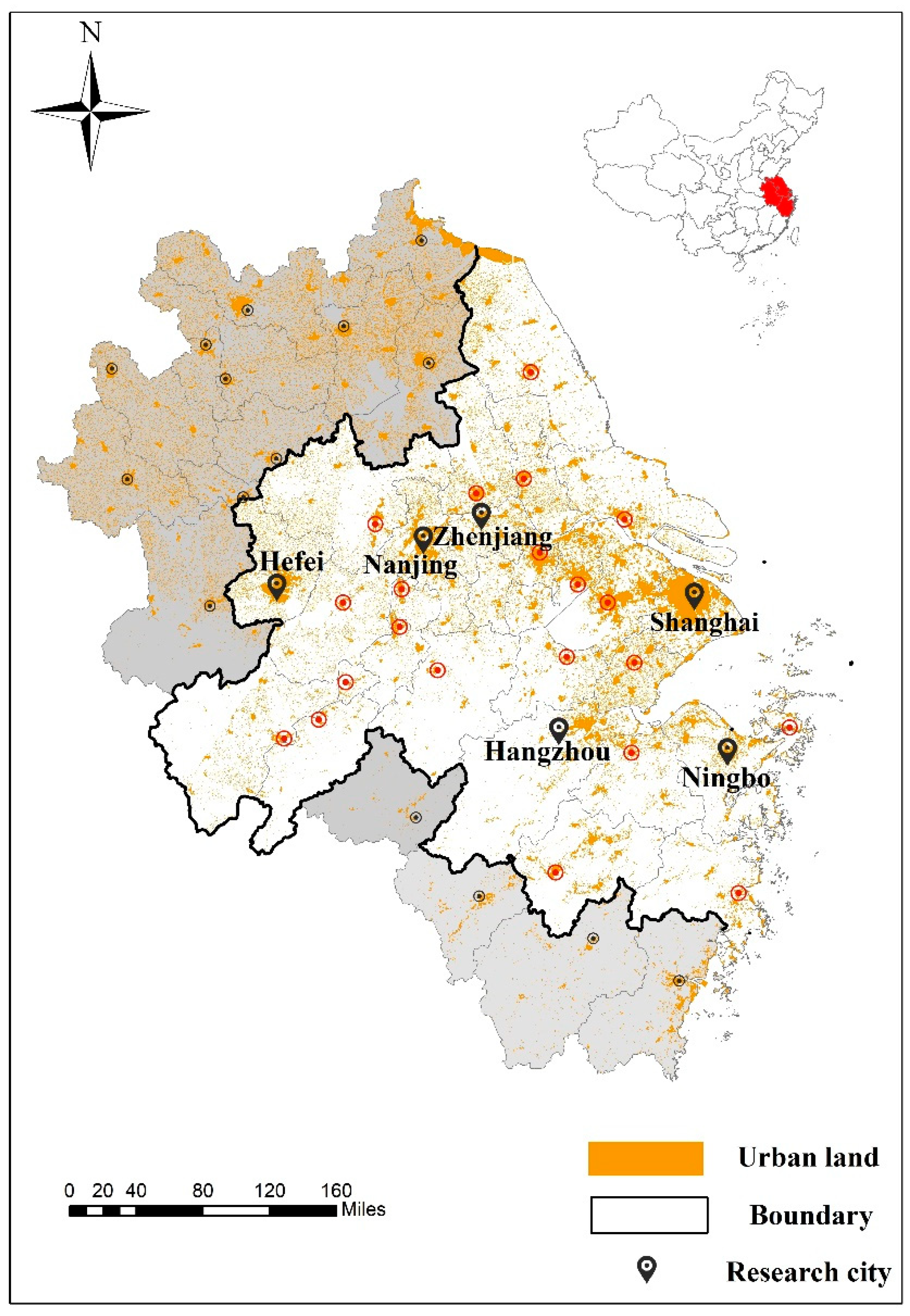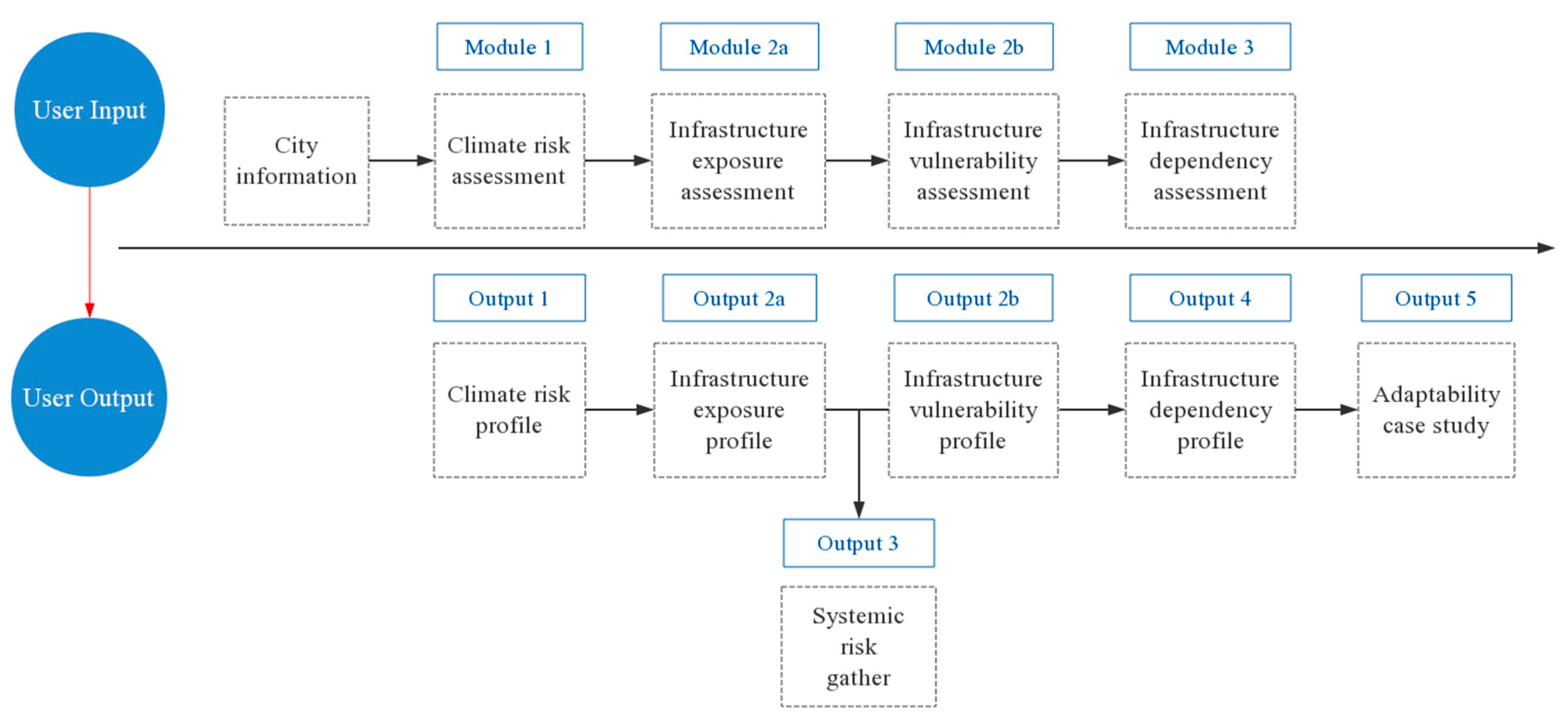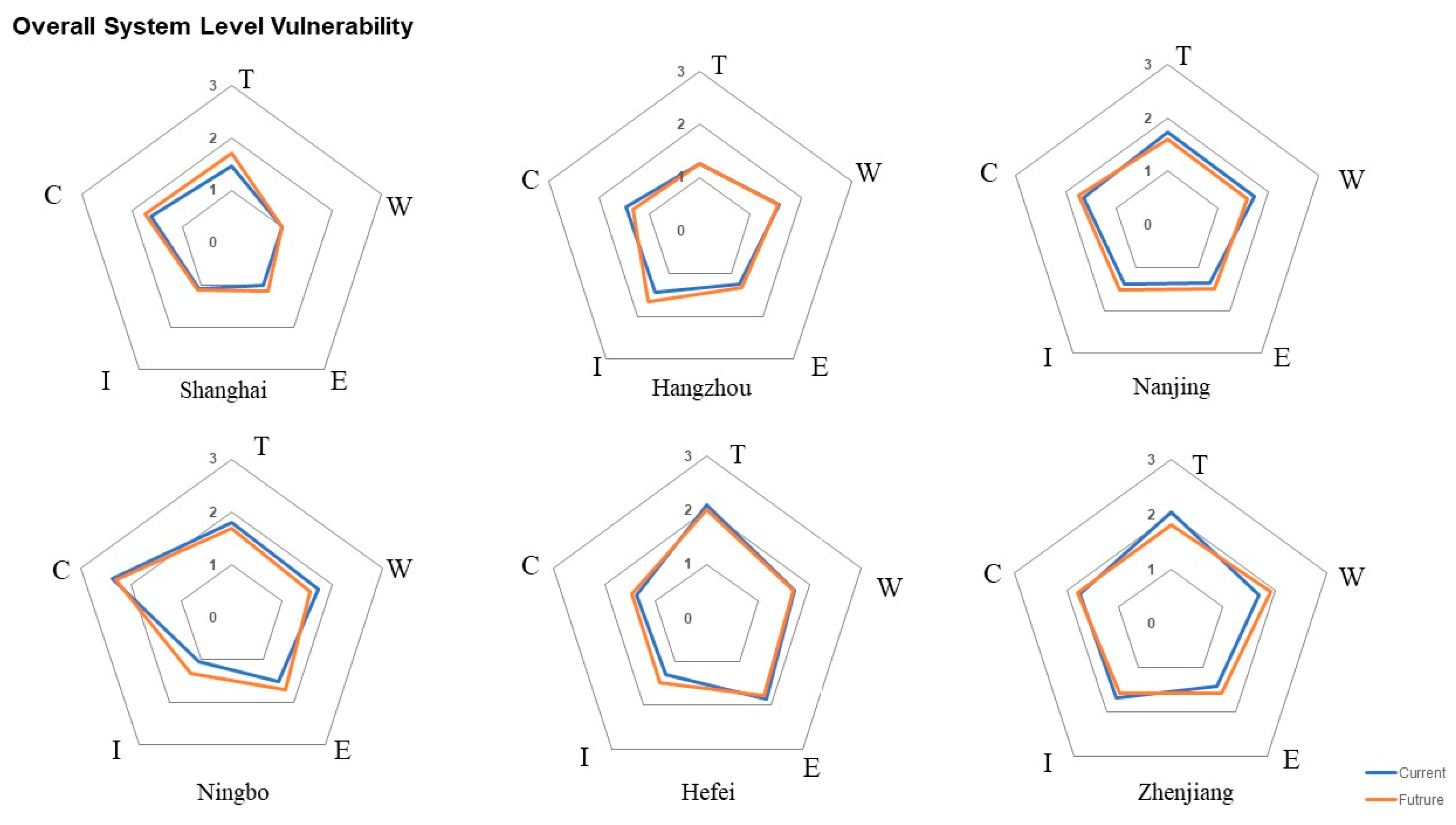An Index-Based Assessment of Perceived Climate Risk and Vulnerability for the Urban Cluster in the Yangtze River Delta Region of China
Abstract
:1. Introduction
2. The Study Area and Focal Hazards
3. Method and Data Collection
3.1. Future Climate Change Projections
3.2. Focus Group Meetings to Collect Key Input to the CIAT Analysis Tool
3.3. The Climate and Infrastructure Assessment Tool (CIAT) and Questionnaire
4. Results and Discussions
4.1. Infrastructure Exposure Assessment
4.2. Infrastructure Vulnerability Assessment
4.3. Analysis of Exposure versus Vulnerability in the Five Infrastructure Sectors
5. Conclusions
Supplementary Materials
Author Contributions
Funding
Acknowledgments
Conflicts of Interest
References
- Van de Sluijs, J.P. Uncertainty and dissent in climate risk assessment: A post-normal perspective. Nat. Cult. 2012, 7, 174–195. [Google Scholar] [CrossRef]
- Howarth, C.; Morse-Jones, S.; Kythreotis, A.P.; Brooks, K. Co-producing UK climate change adapation policy: An analysis of the 2012 and 2017 UK Climate Change Risk Assessments. Enviorn. Sci. Policy 2018, 89, 412–420. [Google Scholar] [CrossRef]
- Intergovernmental Panel on Climate Change. Managing the Risks of Extreme Events and Disasters to Advance Climate Change Adaptation; Intergovernmental Panel on Climate Change: Cambridge, UK, 2012. [Google Scholar]
- Granberg, M.; Glover, B. Adaptation and Maladaptation in Australian national climate change policy. J. Environ. Plan. Policy Manag. 2014, 16, 147–159. [Google Scholar] [CrossRef]
- Massey, E.; Huitema, D. The emergence of climate change adapation as a new field of public policy in Europe. Reg. Enviorn. Chang. 2016, 16, 553–564. [Google Scholar] [CrossRef]
- Kaspersen, P.S.; Halsnaes, K. Integrated climate change risk management: A practical application for urban flooding during extreme precipitation. Clim. Serv. 2017, 6, 55–64. [Google Scholar] [CrossRef]
- Wu, S.; Pan, T.; He, S. Climate change risk research: A case study on flood disaster risk in China. Adv. Clim. Chang. Res. 2012, 3, 92–98. [Google Scholar]
- Millar, C.I.; Stephenson, N.L.; Stephens, S.L. Climate change and forests of the future: Managing in the face of uncertainty. Ecol. Appl. 2007, 17, 2145–2151. [Google Scholar] [CrossRef]
- Nemet, G.F.; Holloway, T.; Meier, P. Implications of incorporating air-quality co-benefits into climate change policymaking. Environ. Res. Lett. 2010, 5, 014007. [Google Scholar] [CrossRef] [Green Version]
- Li, Y.; Ye, W.; Wang, M.; Yan, X. Climate change and drought: A risk assessment of crop-yield impacts. Clim. Res. 2009, 39, 31–46. [Google Scholar] [CrossRef]
- Nguyen, T.T.X.; Bonetti, J.; Rogers, K.; Woodroffe, C.D. Indicator-based assessment of climate-change impacts on coasts: A review of concepts, methodological approaches and vulnerability indices. Ocean Coast. Manag. 2016, 123, 18–43. [Google Scholar] [CrossRef] [Green Version]
- Tapia, C.; Abajo, B.; Feliu, E.; Mendizabal, M.; Martinez, J.A.; Fernández, J.G.; Laburu, T.; Lejarazu, A. Profiling urban vulnerabilities to climate change: An indicator-based vulnerability assessment for European cities. Ecol. Indic. 2017, 78, 142–155. [Google Scholar] [CrossRef]
- Tate, E. Uncertainty Analysis for a Social Vulnerability Index. Ann. Assoc. Am. Geogr. 2013, 103, 526–543. [Google Scholar] [CrossRef]
- Harvey, A.; Hinkel, J.; Horrocks, L.; Klein, R.J.T.; Lasage, R.; Hodgson, N.; Sajwaj, T.; Benzie, M. Preliminary Assessment and Roadmap for the Elaboration of Climate Change Vulnerability Indications at Regional Level; AEA: London, UK, 2009. [Google Scholar]
- Hinkel, J. Indicators of vulnerability and adaptive capacity: Towards a clarification of the science-policy interface. Glob. Environ. Chang. 2011, 21, 198–208. [Google Scholar] [CrossRef]
- Schröter, D.; Cramer, W.; Leemans, R.; Prentice, I.C.; Araujo, M.B.; Arnell, N.W.; Bondeau, A.; Bugmann, H.; Carter, T.R.; Gracia, C.A.; et al. Ecosystem Service Supply and Vulnerability to Global Change in Europe. Science 2005, 310, 1333–1337. [Google Scholar]
- Yohe, G.; Malone, E.L.; Brenkert, A.L.; Schlesigner, M.; Meij, H.; Lee, D. Geographic Distributions of Vulnerability to Climate Change. Integr. Assess. J. 2006, 6, 3. [Google Scholar]
- Mahendra, R.S.; Mohanty, P.C.; Bisoyi, H.; Kumar, T.S.; Nayak, S. Assessment and management of coastal multi-hazard vulnerability along the Cuddaloree-Villupuram, east coast of India using geospatial techniques. Ocean Coast. Manag. 2011, 54, 302–311. [Google Scholar] [CrossRef]
- Eriksen, S.H.; Kelly, P.M. Developing credible vulnerability indicators for climate adaptation policy assessment. Mitig. Adapt. Strateg. Glob. Chang. 2007, 12, 495–524. [Google Scholar] [CrossRef]
- Tol, R.; Yohe, G. The weakest link hypothesis for adaptive capacity: An empirical test. Glob. Environ. Chang. 2007, 17, 218–227. [Google Scholar] [CrossRef] [Green Version]
- Füssel, H. Review and quantitative analysis of indices of climate change exposure, adaptive capacity, sensitivity and impacts. In World Bank Development Report 2010: Development and Climate Change; World Bank: Potsdam, Germany, 2010. [Google Scholar]
- Van Velthuizen, V.; Huddelston, B.; Fischer, G.; Salvatore, M.; Ataman, E.; Nachtergaele, F.O.; Zanetti, M.; Bloise, M. Mapping Biophysical Factors That Influence Agricultural Production and Rural Vulnerability; FAO: Rome, Italy, 2007. [Google Scholar]
- Moss, R.H.; Edmonds, J.A.; Hibbard, K.A.; Mannings, M.R.; Rose, S.K.; van Vuuren, D.P.; Carter, T.R. The next generation of scenarios for climate change research and assessment. Nature 2010, 463, 747–756. [Google Scholar] [CrossRef]
- EB-CMDD. China Meteorological Disasters Dictionary (Zhejiang Vol.); China Meteorological Press: Beijing, China, 2006. [Google Scholar]
- EB-CMDD. China Meteorological Disasters Dictionary (Shanghai Vol.); China Meteorological Press: Beijing, China, 2006. [Google Scholar]
- EB-CMDD. China Meteorological Disasters Dictionary (Jiangsu Vol.); China Meteorological Press: Beijing, China, 2008. [Google Scholar]
- Zhang, Y.; Fan, G.; He, Y.; Cao, L. Risk assessment of typhoon disaster for the Yangtze River Delta of China, Geomatics. Nat. Hazards Risk 2017, 8, 1580–1591. [Google Scholar] [CrossRef]
- Wang, C.; Du, S.; Wen, J.; Zhang, M.; Gu, H.; Shi, Y.; Xu, H. Analyzing explanatory factors of urban pluvial floods in Shanghai using geographically weighted regression. Stoch. Environ. Res. Risk Assess. 2017, 31, 1777–1790. [Google Scholar] [CrossRef]
- Chen, Q.; Ding, M.; Yang, X.; Hu, K.; Qi, J. Spatially explicit assessment of heat health risk by using multi-sensor remote sensing images and socioeconomic data in Yangtze River Delta, China. Int. J. Health Geogr. 2018, 17, 15. [Google Scholar] [CrossRef]
- Xie, X.; Zheng, Y.; Pan, J. Urban Vulnerability and Adaptability to Climate Change: A Case Study of Cities in the Yangtze River Delta. Chin. J. Urban Environ. Stud. 2018, 6, 1850006. [Google Scholar] [CrossRef]
- Du, H.; Wang, D.; Wang, Y. Influences of land cover types, meteorological conditions, anthropogenic heat and urban area on surface urban heat island in the Yangtze River Delta Urban Agglomeration. Sci. Total Environ. 2016, 571, 461–470. [Google Scholar] [CrossRef]
- Huang, Q.; Lu, Y. The effect of urban heat island on climate warming in the Yangtze River Delta urban agglomeration in China. Int. J. Environ. Res. Public Health 2015, 12, 8773–8789. [Google Scholar] [CrossRef]
- Nicholls, R.J. Adapation Options for Coastal Areas and Infrastrature: An Analysis for 2030; Report to the UNFCCC; UNFCCC: Bonn, Germany, 2007. [Google Scholar]
- Rajbhandari, R.; Shrestha, A.B.; Kulkarni, A.; Patwardhan, S.K.; Bajracharya, S.R. Projected changes in climate over the Indus river basin using a high resolution regional climate model (PRECIS). Clim. Dyn. 2015, 44, 339–357. [Google Scholar] [CrossRef]
- Rao, K.K.; Patwardhan, S.K.; Kulkarni, A.; Kamala, K.; Sabade, S.S.; Kumar, K.K. Projected changes in mean and extreme precipitation indices over India using PRECIS. Glob. Planet. Chang. 2014, 113, 77–90. [Google Scholar] [CrossRef]
- Zhu, J.; Huang, G.; Wang, X.; Cheng, G.; Wu, Y. HIgh-resolution projections of mean and extreme precipitations over China through PRECIS under RCPs. Clim. Dyn. 2018, 50, 4037–4060. [Google Scholar] [CrossRef]





| City | Resident Population (10,000 People) | Scale | Major Meteorological Disaster |
|---|---|---|---|
| Shanghai | 2418.33 | Megacity | Rainstorm, typhoon, heat waves. |
| Nanjing | 833.5 | Big City | Rainstorm, typhoon. heat waves, cold spells |
| Hangzhou | 946.8 | Rainstorm, typhoon, heat waves, cold spells | |
| Hefei | 796.5 | Rainstorm, typhoon, heat waves, cold spells | |
| Ningbo | 800.5 | Rainstorm, typhoon, heat waves, cold spells | |
| Zhenjiang | 318.63 | Medium-sized City | Rainstorm, typhoon, heat waves, cold spells |
| Flood | Heat Wave | Rainstorm | Typhoon | |||||||||||||||||||||
|---|---|---|---|---|---|---|---|---|---|---|---|---|---|---|---|---|---|---|---|---|---|---|---|---|
| Current | Future | Current | Future | Current | Future | Current | Future | |||||||||||||||||
| High | Mid | Low | High | Mid | Low | High | Mid | Low | High | Mid | Low | High | Mid | Low | High | Mid | Low | High | Mid | Low | High | Mid | Low | |
| Main road | √ | √ | √ | √ | √ | √ | √ | √ | ||||||||||||||||
| Main Tunnel | √ | √ | √ | √ | √ | √ | √ | √ | ||||||||||||||||
| Subway | √ | √ | √ | √ | √ | √ | √ | √ | ||||||||||||||||
| Port | √ | √ | √ | √ | √ | √ | √ | √ | ||||||||||||||||
| Airport | √ | √ | √ | √ | √ | √ | √ | √ | ||||||||||||||||
| Description | Planning and Design | Operation and Maintenance | Future Vulnerability | |||||||
|---|---|---|---|---|---|---|---|---|---|---|
| Infrastructure | Main Climate Disaster | Environmental and Climate Risks Assessment | Risk Design | Defense Facility | Monitoring Mechanism | Emergency Mechanism | Regular Maintenance | Regularly Updated | Climate Consultation | Medium/Long Term Climate Change |
| Main road | Flood/heat wave/rainstorm/typhoon | Experts were consulted about current risks | Partly and/or some hazards | Protective infrastructure for highlighted hazards | Infrequent monitoring | Effective procedures in place, regularly reviewed | Irregular maintenance undertaken | Upgraded to accommodate new technologies only | Consulted but not fully | Designed for predicted 30 year changes but not 50 year changes |
| Main Tunnel | Flood/heat wave/rainstorm/typhoon | Don’t know | All hazards were considered | Protective infrastructure in place for all relevant hazards | Continuous monitoring using smart technology | Procedures exist but rarely checked/tested | Appropriate, regular maintenance | Upgraded for new technologies and changes in environmental & social conditions | Consulted as part of a collaborative planning process. | Don’t know |
| Subway | Flood/heat wave/rainstorm/typhoon | Full risk assessment done for current and future risks | All hazards were considered | Protective infrastructure for highlighted hazards | Infrequent monitoring | Procedures exist but rarely checked/tested | Irregular maintenance undertaken | Upgraded to accommodate new technologies only | Consulted but not fully | Designed for predicted 50 year + changes |
| Port | Flood/heat wave/rainstorm/typhoon | Don’t know | Partly and/or some hazards | Protective infrastructure in place for all relevant hazards | Continuous monitoring using smart technology | Effective procedures in place, regularly reviewed | Appropriate, regular maintenance | Upgraded for new technologies and changes in environmental &social conditions | Consulted but not fully | Designed for predicted 50 year + changes |
| Airport | Flood/heat wave/rainstorm/typhoon | Experts were consulted about current risks | All hazards were considered | Protective infrastructure for highlighted hazards | Infrequent monitoring | Effective procedures in place, regularly reviewed | Irregular maintenance undertaken | Upgraded to accommodate new technologies only | Consulted but not fully | Designed for predicted 50 year + changes |
© 2019 by the authors. Licensee MDPI, Basel, Switzerland. This article is an open access article distributed under the terms and conditions of the Creative Commons Attribution (CC BY) license (http://creativecommons.org/licenses/by/4.0/).
Share and Cite
Sun, L.; Tian, Z.; Zou, H.; Shao, L.; Sun, L.; Dong, G.; Fan, D.; Huang, X.; Frost, L.; James, L.-F. An Index-Based Assessment of Perceived Climate Risk and Vulnerability for the Urban Cluster in the Yangtze River Delta Region of China. Sustainability 2019, 11, 2099. https://doi.org/10.3390/su11072099
Sun L, Tian Z, Zou H, Shao L, Sun L, Dong G, Fan D, Huang X, Frost L, James L-F. An Index-Based Assessment of Perceived Climate Risk and Vulnerability for the Urban Cluster in the Yangtze River Delta Region of China. Sustainability. 2019; 11(7):2099. https://doi.org/10.3390/su11072099
Chicago/Turabian StyleSun, Landong, Zhan Tian, Huan Zou, Lanzhu Shao, Laixiang Sun, Guangtao Dong, Dongli Fan, Xinxing Huang, Laura Frost, and Lewis-Fox James. 2019. "An Index-Based Assessment of Perceived Climate Risk and Vulnerability for the Urban Cluster in the Yangtze River Delta Region of China" Sustainability 11, no. 7: 2099. https://doi.org/10.3390/su11072099
APA StyleSun, L., Tian, Z., Zou, H., Shao, L., Sun, L., Dong, G., Fan, D., Huang, X., Frost, L., & James, L.-F. (2019). An Index-Based Assessment of Perceived Climate Risk and Vulnerability for the Urban Cluster in the Yangtze River Delta Region of China. Sustainability, 11(7), 2099. https://doi.org/10.3390/su11072099





